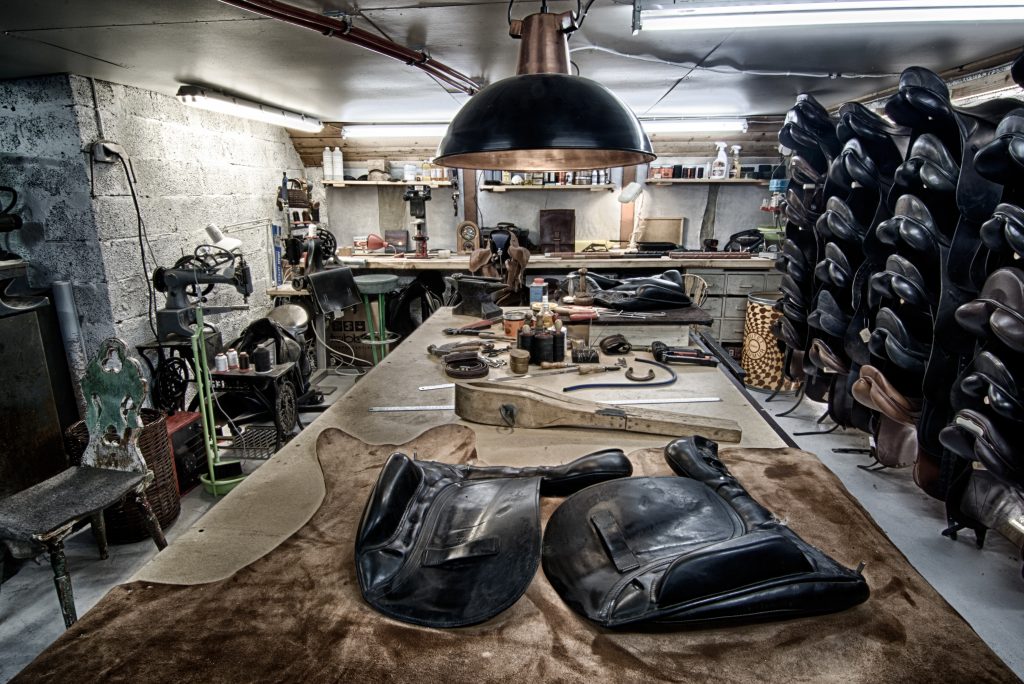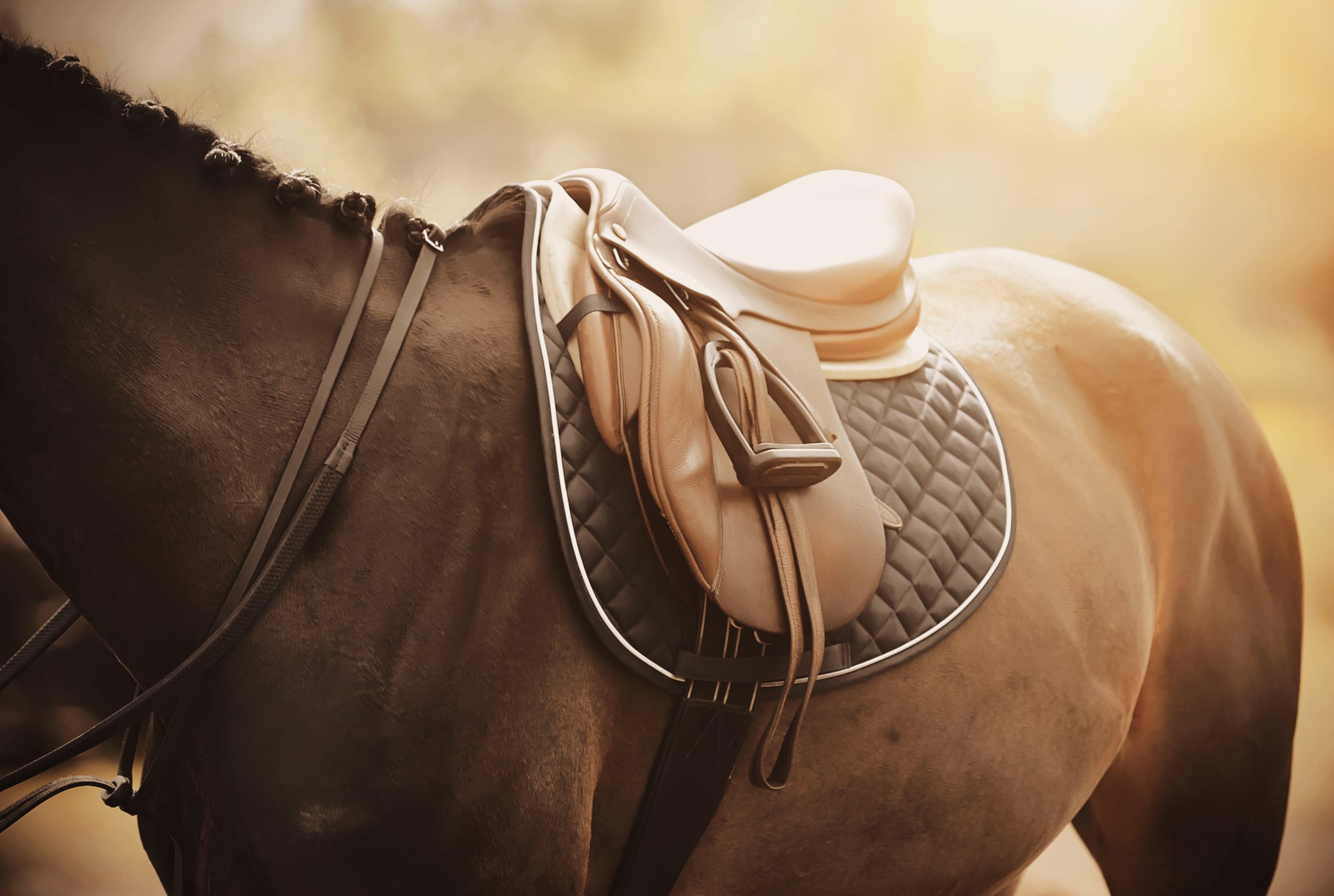The saddle is a vital part of equestrian equipment, enabling the safe practice of horse riding. Choosing the right saddle and fitting it properly means you are able to ride and lead a horse effectively, also protecting the horse’s back.
A saddle should be chosen that reflects the user’s requirements, fitting to the horse as well as the rider.
English Saddles
The first step when choosing and fitting a saddle is to understand the individual characteristics and benefits of each type. The following outlines will give you a guide to the main characteristics of each type of English saddle.
- Dressage saddle
Dressage saddles create a straight position for riders, with less of a bend at the knee. Placed on the back of the horse’s back, they give riders more balance and a static upper body position with their deeper tree.
- Jumping saddle
Jumping saddles are lightweight with a square cantle, placed behind the horse’s shoulder blade. They give riders a leg position that is better suited to dynamic raises while the shallow seat and shorter flaps give riders more movement in the saddle.
- Trekking saddle
The trekking saddle is lightweight and comfortable for both the rider and horse. Trekking saddles typically allow the rider to stand in the saddle or have a light seat for long periods of time.
- All-purpose saddle
The all-purpose saddle is versatile and comfortable, allowing the rider to determine the shape and position they ride in. They can be used for either show jumping or dressage, however their profile is not designed specifically for either discipline.
- Pony saddle
A pony saddles are designed to fit children and teenagers’ bodies without impacting their development. Children often have deep, padded seats with panels and knee blocks attached by Velcro.
Construction of English saddles
- The tree is the light and durable base of the saddle, predominantly made from synthetic materials, fiberglass and resin.
- The seat can vary in size, depth and shape. Made from elasticated material, it goes over the saddle’s cantle, helping to keep your pelvis balanced.
- The pommel is the highest area on the saddle. Located at the front of the saddle, it must be adjusted to fit the horse’s back and prevent injury.
- The cantle cushions and distributes the rider’s weight on the horse’s back.
- The panel is filled with synthetic wool and is located on the bottom of the saddle, adjusted to the arch line of the horse’s back to avoid causing pressure.
- The flaps are where the rider’s legs are held at the side of the horse. These can be adjusted to the length of the rider’s thigh for comfort.
- The knee blocks provide support for riders’ knees. They can come in different shapes, sizes and materials, or even have Velcro attachments for easy adjustments.
- The calf block is designed for the stabilization of riders’ leg positions and can be attached using Velcro.
- Billets are hardy leather straps that attach the girth to the horse, being made of 2 or 3 straps.
- The skirt is the small piece of leather that protects riders’ legs from the metal grapple for comfort.
Saddle fitting

There are many aspects to consider when fitting a saddle, including the rider’s height, weight, level of expertise and the shape of the horse’s back.
The following sections highlight some of the main considerations when fitting a saddle:
English saddle sizes
Seat size
First, you should determine the correct seat size. The rider’s weight and height can work as a rough guide to seat size, however this should also be based on the rider’s hips and pelvis width, as well as the horse.
| Seat size [inch] | Rider’s weight [kg] |
| 15″ – 15 3/4″ | Up to 40 kg |
| 16″ – 16,5″ | 41 to 51 kg |
| 17″ – 17,5″ | 56 to 79 kg |
| 18″ | 80 to 120 kg |
| Seat size [inch] | Rider’s height [m] |
| 15″ to 16″ | 1,45 m to 1,65 m |
| 16,5″ to 17,5″ | 1,65m to 1,75 m |
| 17″ to 18″ | 1,75 m to 1,90 m |
Withers bar
Next, you should fit the withers bar, which is the opening at the front of the saddle, taking the horse’s back anatomy into account while making sure it is level with the horse’s shoulder girdle.
While producers’ measurements vary, here is the Prestige Italia and Renaissance chart as a guide:
| Withers bar | Horse’s back characteristics |
| 29-32 | is a narrow size, for horses with dominating, sticking up withers |
| 33-34 | is considered a standard size, the most popular one |
| 36 and up | for horses without clear withers – the so-called round horses |
Centre of gravity
The centre of gravity should be determined so the lowest point in the saddle seat is at the highest point of the horse’s back. This will mean the rider moves with the horse.
What else can you order for saddles?
Flaps – You can personalise flaps depending on your preferences.
Blocks type and size – These can be purchased in various sizes, or even removed, making riders feel safe while helping to position the rider’s legs comfortably.
Leather type – Different leathers can offer a smoother feel, more hardy surface, different appearances or non-slip benefits.
High quality equipment – your saddle may last longer if stirrup leathers are of a high quality, preventing damage.
Wrongly fitted saddle
A wrongly fitted saddle should be corrected as quickly as possible to prevent injury to your horse. If you are unsure of how to correctly fit saddles, you can ask a qualified saddle fitter for help.
Common symptoms of a wrongly fitted saddle include:
- An imbalanced saddle
- Regularly detached cantles
- Curvatures and irregular lameness
- A horse being scared or biting when the saddle is put on
A wrongly fitted saddle is not always the cause of the above symptoms. It can also be due to:
- Intensive training
- A change in diet or the horse’s weight
- Poor rider balance
- Overusing riding aids
Saddle correction pads
There are many types of pads available on the market, being a useful aid to fit one saddle to different horses, cushioning impact and filling unevenness.
Purchase from experienced companies that can advise you, making sure you do everything possible to provide yourself and your horse with the best fitting saddle.
Would you like to read more about how to choose and fit a saddle for you and your horse?
